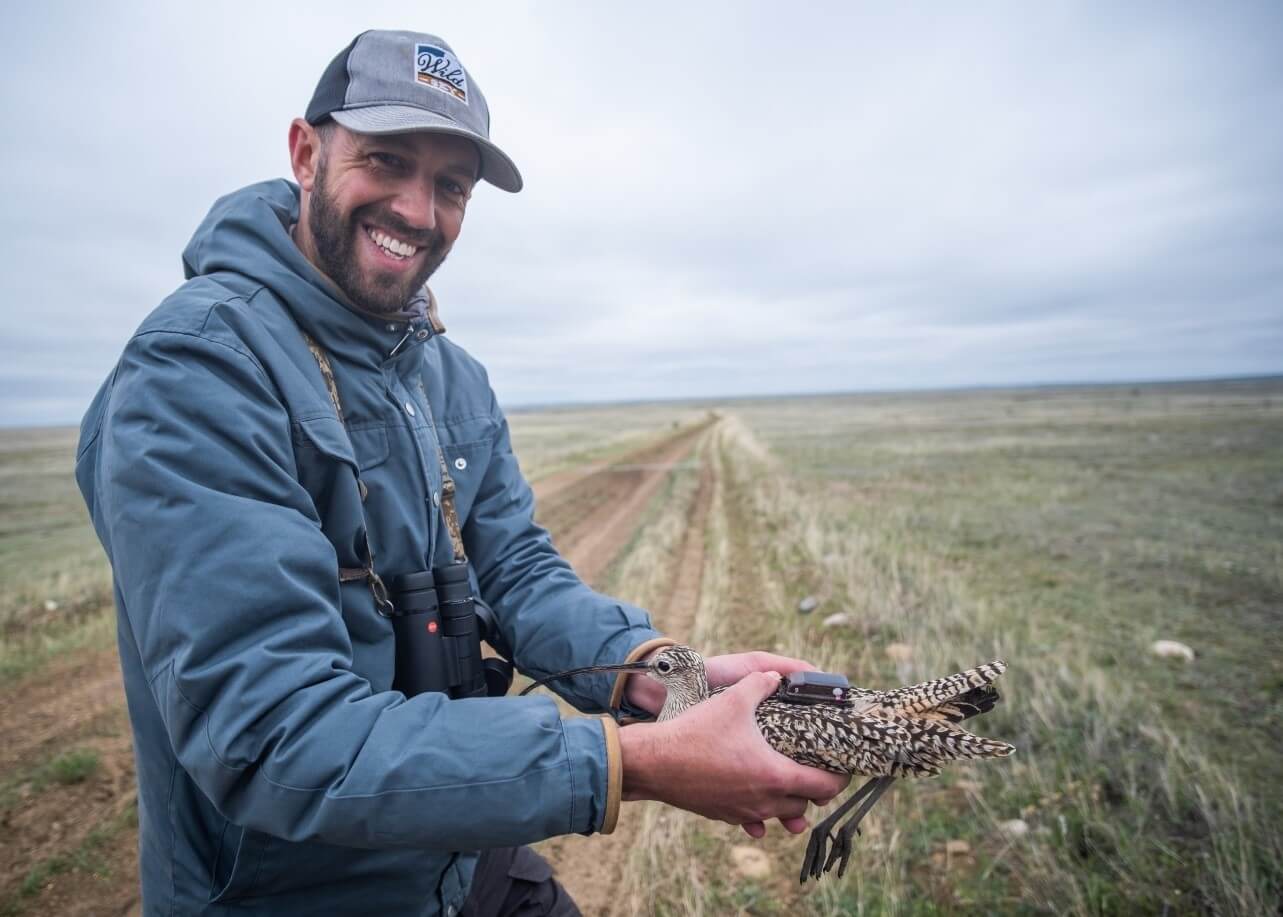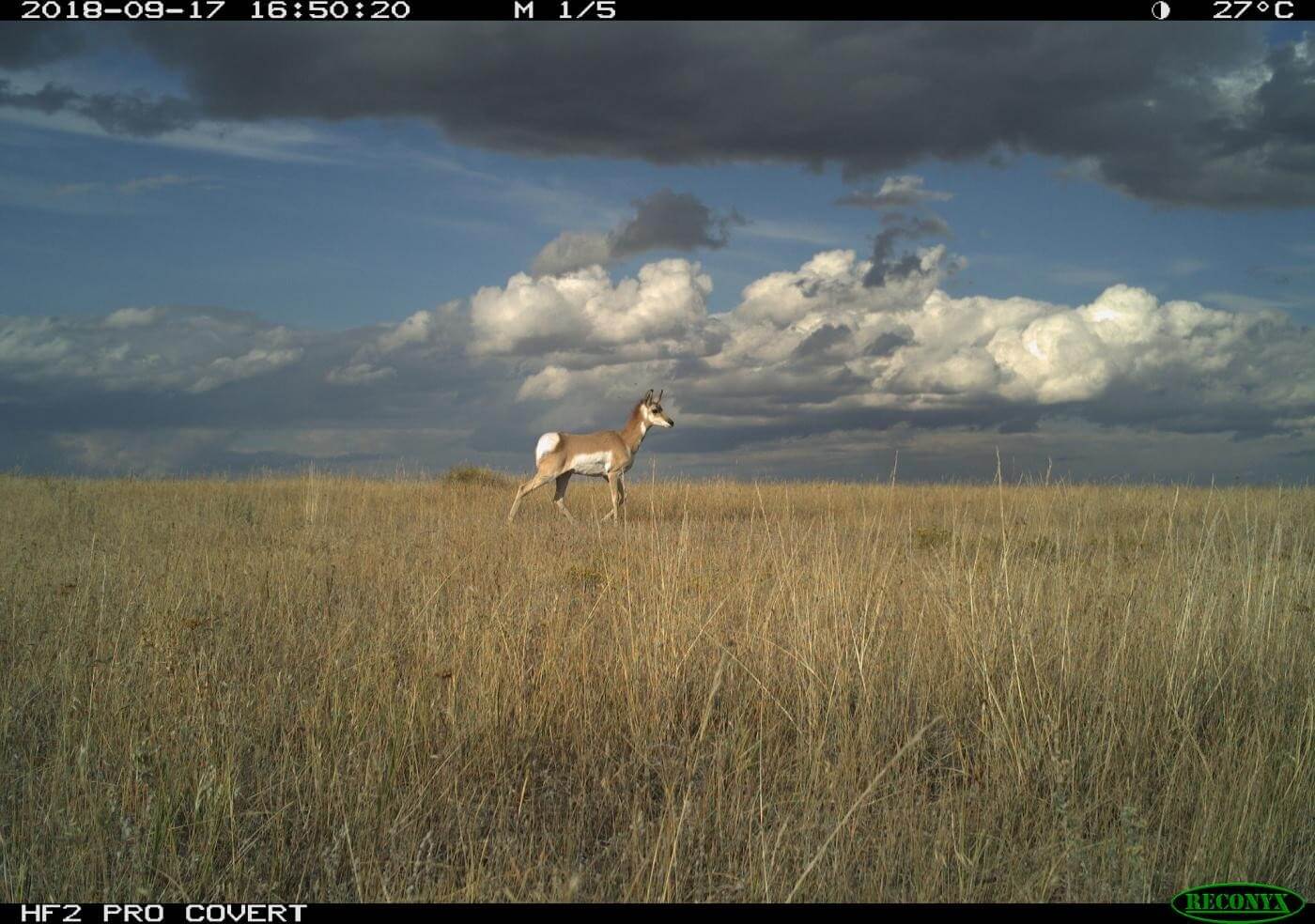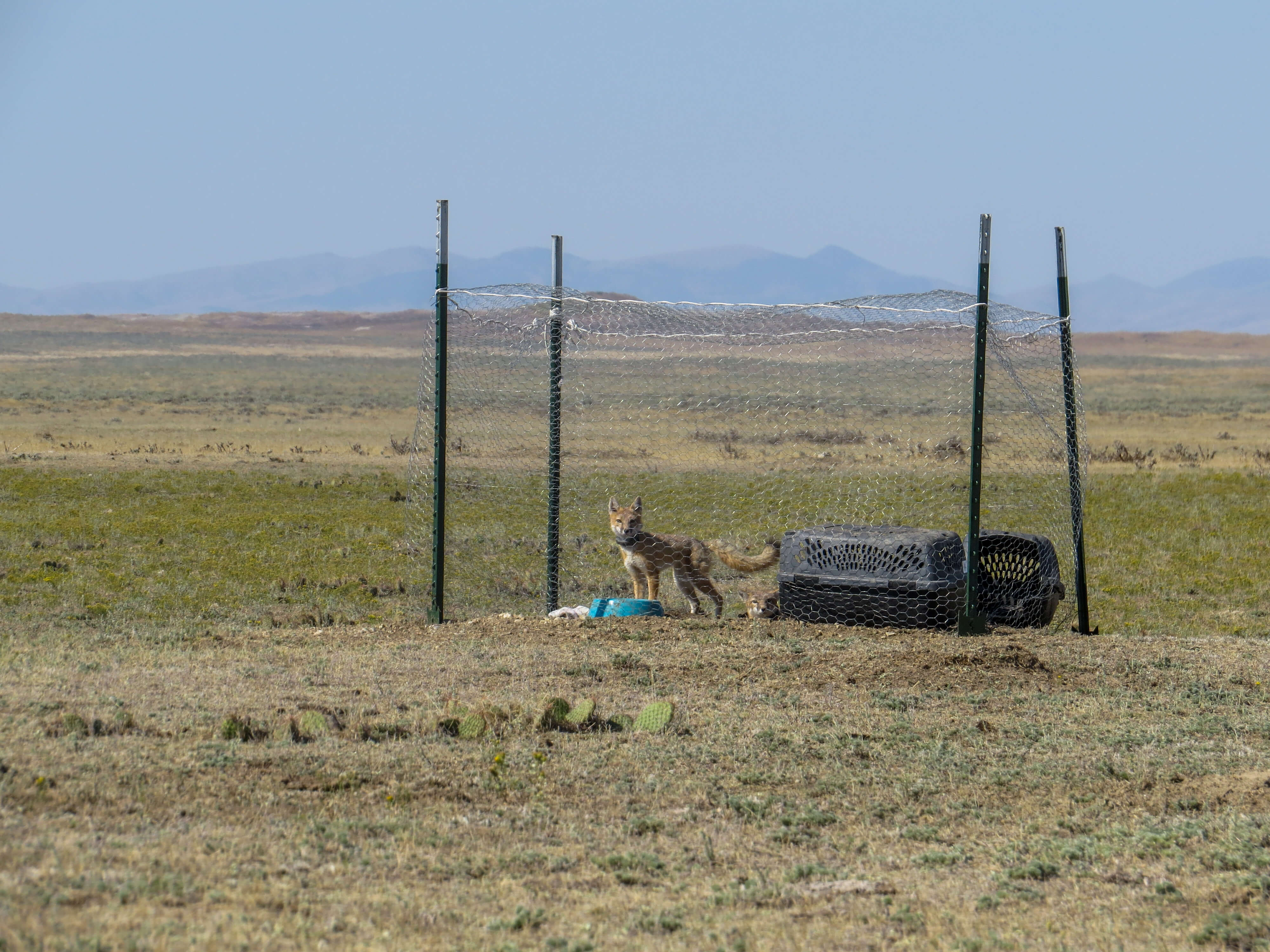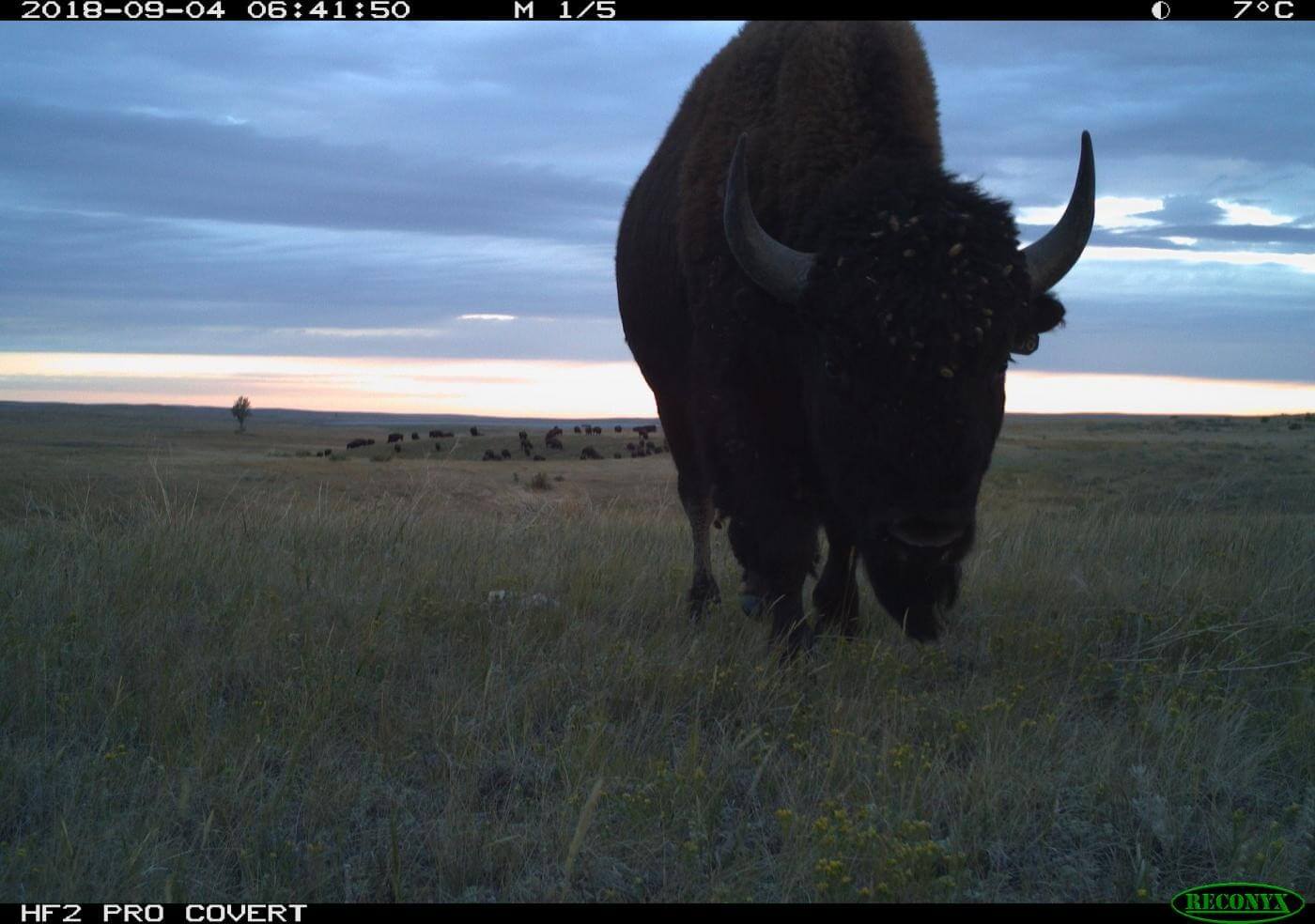As part of American Prairie’s ongoing partnership with the Smithsonian Conservation Biology Institute, ecologists Hila Shamon, Ph.D. and Andy Boyce, Ph.D. are conducting groundbreaking wildlife research on the prairie.
After a busy year in the field, they sat down with American Prairie Wildlife Restoration Manager Daniel Kinka, Ph.D., to reflect on their work in 2020 and to discuss how this unique partnership is advancing our understanding of the prairie ecosystem.
Kinka: Could you please introduce yourselves with some background on what you do at Smithsonian?
Boyce: Yeah, my name is Andy Boyce and I’m an avian ecologist with the Smithsonian Conservation Biology Institute. I’ve worked with birds all over the world, understanding their ecology, evolution, and breeding biology. I did my Ph.D. degree at the University of Montana in Missoula and am just super excited to be back in Montana working on bird conservation.

Shamon: My name is Hila Shamon. I’m a wildlife ecologist with the Smithsonian Conservation Biology Institute. Most of my work is on the border between landscape ecology and conservation biology, mostly working on large mammals. I’m very interested in movement ecology and species distributions. I currently work on several projects relating to mammals and species reintroductions like bison and swift fox.

Kinka: Before we drill down into what both of you are doing now in your research, I think it helps to better understand the work you do if we can understand what makes you tick. So I’m wondering if you could briefly tell me a story about why you ended up where you are? What made you want to become a researcher?
Shamon: I’m so simple. I’ve always wanted to be a wildlife researcher. I was always connected to wildlife. I was always interested in animals. I always collected animals when I was walking around on the hills by my house as a child. Anything I could find, I brought home. My parents had a difficult time with many stray dogs, cats, and birds that I used to find. No life-changing events. It’s just me. I was born this way.
Boyce: Like Hila, I was always interested in being outside and interested in animals and learning about all the creatures that lived in my yard, from pumpkinseed and largemouth bass in the pond to salamanders under the logs. Birds actually came much later. I think I basically sort of transitioned from it being my passion to a goal of working outside around animals. I always remember being in places where animals were and being observant and just paying attention to them. That’s when I think my focus started to shift, wondering why are there some places that we see a lot of animals and they seem to be doing well and why are there some other places where we don’t?
Kinka: What are you two currently working on at American Prairie Reserve?
Boyce: We’re a couple years into this partnership, and Hila and I both have multiple projects all at different stages. For me this year, it’s been super exciting wrapping up what I generally refer to as the grassland bird work. We’re trying to understand what effects putting bison back on the landscape has on grassland bird communities, especially to bird species that are imperiled. This includes grassland songbirds like Sprague’s pipit and Baird’s sparrow, and shorebirds like long-billed curlew and mountain plover.
2020 was also the second year of our long-billed Curlew movement ecology work, and that’s been really exciting. The main goal of that project is to understand how these shorebirds select their habitat relative to active prairie dog towns. We know that curlews co-evolved with prairie-dogs on the great plains, but as prairie dogs have been extirpated from much of the West, we don’t understand the potential impact on birds like curlews because we don’t fully understand the biological links between those species. This work is about identifying and describing those links. American Prairie Reserve has been a great place to do that work because of the work you’re doing for the benefit of prairie dogs. But it’s also been phenomenal because we get to follow these birds using GPS tags throughout every day of the year. This year, we created a partnership with an organization called OVIS (Organizacion Vida Silvestre) in Mexico. They’re using data from the birds that we tagged on American Prairie Reserve to inform on-the-ground conservation efforts in the Chihhuahuan Desert of Mexico.
Another big project on the horizon is studying a small grasslands bird called a Sprague’s pipit. We’re using an animal tracking system called Motus, which is a system of towers all over the world. This allows us to put tags on really tiny birds and even large insects. When the birds or insects fly past these towers, we get a little bit of a signal that says this animal is here right now. That might not sound like much, but when you tag a bunch of birds and have an amazing network of towers all over the world, you can really start to learn amazing things. Where do these birds travel? What are their migratory routes? What are the tough times of year for these birds? Where are they dying? It’s a bit of a morbid question, but it’s an important question. If you’re trying to understand what we need to do to improve the populations of birds, understanding where survival bottlenecks are is really important. Are they dying on the breeding grounds? Is it during migration or on the wintering grounds?
Kinka: What does a day of this type of research look like?
Boyce: You know, a large part of the work is just old school field ecology. Waking up at 3:45 in the morning and driving long distances on bad roads to get to our sampling locations. And then we go out and count birds, recording audio and measuring vegetation conditions in the places where we’re recording those birds. Then we pair that up with maps and data that we have on hand about what areas are grazed by cattle and what areas are grazed by bison. So it’s pretty old school. There isn’t a lot of crazy technology associated with that part of it. It’s just being really good at telling the difference between a Baird’s sparrow and a grasshopper sparrow at 200 meters without ever seeing the bird.
On the other hand, understanding these riparian areas (streams and rivers) can be more complex than just describing how tall the grass is, so we’re getting quite a bit more sophisticated with technology. This is where Hila’s work plays a big role. We’re using data from satellites to study what an area is doing over a 10- or 15-year period in areas where American Prairie Reserve has reintroduced bison compared to areas that have cattle.
Shamon: Parallel to Andy’s work on grassland birds we also deployed thousands of cameras across American Prairie Reserve, Bureau of Land Management lands, the Charles M. Russell National Wildlife Refuge, and the Fort Belknap Reservation to learn about mammal activity patterns throughout the region. We wanted to see if any of the active grazing management in the region has any effects on these species.
We found out that in terms of mammals at least, they move around so much that we could not pick up any differences between cattle-grazed areas compared to bison-grazed areas. It was more of the landscape features and the habitat types that dictated the patterns we were seeing. So we took a step back, and then we analyzed those entire data sets looking at the different ungulate species, whether it’s elk, mule deer, whitetail deer, or pronghorn. We wanted to assess their responses to different stages of grass growth in four habitat or patch types: grass, prairie dog towns, and riparian sites. What we saw was a very complex picture where each of the species that occurs in the region has a unique strategy to utilize resources.

Another aspect that I am interested in is to examine to what extent bison manipulate grass growth under the current grazing management and what are the effects on other species. There was a big paper that came out of Yellowstone National Park in 2019 about bison engineering the “green wave.” What this research group saw is that bison were going back to places they already grazed, creating these grazing lawns, going back and forth and back and forth reusing different areas. By doing that, they kept the vegetation in an earlier growth stage, similar to how you would mow your lawn. This basically keeps the vegetation stage, not only for bison but also for other species that graze on that grass. Now we’re interested to see if we’re picking up the same patterns in plains systems.
We plan to do this using several methods. We will track bison movement, assess vegetation greenness using remote sensing methodologies, and we will deploy camera traps and audio recorders for other wildlife – mammals, birds, insects, and amphibians. We started some of this work this year. Instead of sampling the entire region, we scaled down to a very fine-scale grid and placed a camera and audio recorder every kilometer, sampling 80 locations or 80 km2. This dataset will provide information on multiple species space use in relation to bison grazing patterns.
Kinka: I know the pandemic affected how your team was able to work in the field this season. What were those challenges like and how did you address them?
Shamon: It was nerve-wracking for both of us before the field season started because none of us really knew if we’d even be able to come out and do field work this year. As the weeks passed, we got more clarity on what our new life was going to be like. We were very fortunate to work with American Prairie Reserve. Your team was able to accommodate us in a way that would keep us safe. We still had to make sure that all the COVID limitations and restrictions were met in housing and lodging. On the Smithsonian side, there was a lot of planning we had to go through, and we had to write up a protocol for every single activity that we were thinking about undertaking in the field.
Boyce: I think people like us who have worked in a lot of crazy, out-of-the-way places doing weird, challenging stuff are used to unpredictable situations. That forces you to adapt quickly. In some ways, this was just another big curveball.
As Hila mentioned, we were writing a lot of safety protocols for absolutely every activity we were doing. So if you want to go do bird surveys in riparian areas, we need to write a protocol that is spelling out in great detail exactly how we’re mitigating absolutely every possible COVID risk. Because Montana had very little COVID activity compared to the rest of the country in the early part of the pandemic, we were able to work on this stuff and I think it helped figure out how we can do field work safely for Smithsonian as a whole.
We had to have huge support from American Prairie on the logistics, and in some ways, to be safe, we just had to space people out. That means more vehicles, more rooms, etc. In reality, just the pure remoteness of the prairie was a big ally. Everyone coming to the field also had to quarantine for two weeks prior.
Kinka: The swift fox restoration was such a great story this year. Hila, can you give us a recap of that project please?
Shamon: This is a project that actually started off with American Prairie Reserve trying to reintroduce swift fox to the prairie a few years ago. Your team did a lot of work planning and getting people involved in that plan, including Fort Belknap and other researchers and experts. Then in 2018, American Prairie asked Smithsonian to join this effort and to conduct the science involved with this effort. Smithsonian took the lead with the Fort Belknap Indian Reservation being the primary site for the reintroduction.
We conducted about two years’ worth of assessments to assess the feasibility of the reintroduction. When you want to reintroduce a species, you have to make sure the habitat can sustain that species. We came to the conclusion that the habitat is extremely suitable and that there’s enough space to reintroduce swift fox to this region.
We contacted three states that would potentially provide a source population, and they all agreed and got on board with the project after we gave them a reintroduction plan and protocol. Those states are Wyoming, Colorado, and Kansas. The reintroduction is a five-year project, where every year we source between 40 to 50 individuals from one of those source populations and translocate foxes to Fort Belknap. We tag each individual with a GPS so we can track their movements and know their whereabouts, where they’re establishing their home ranges, and learn about survival. This is key for a successful project. We have to be ready to adapt to protocols if reality is different than our projections.

Kinka: Can you explain what the significance of this is? What is the point of doing a species reintroduction like this in a general sense and then specifically for swift fox.
Shamon: So usually, we want to reintroduce species that are gone from a certain place and that fill some kind of role within that ecosystem. Then we have to think really hard, especially when there are several species that are gone, about what it would mean for that ecosystem. As a rule of thumb, we usually try to reintroduce the last species that was extirpated from a certain place and also take into consideration their ecological role in that ecosystem. Before you do any range reduction, you have to go through many, many steps to assess the viability of that reintroduction to make sure it’s a good idea.
Swift fox were quite abundant across the Great Plains, and then by the mid 20th century, they were basically extirpated from most of their historic range. They slowly reoccupied thanks to different conservation initiatives and naturally recolonizing different areas across their historic range. Today, it’s about 40 percent of their historic range. Here in Montana, we have an established population thanks to a big reintroduction program in Canada about 20 years ago where foxes expanded into Montana and two smaller reintroductions to Blackfeet Nation and Fort Peck. But there’s a gap of about 200 miles between the northern population that exists on the Canadian border and the rest of swift fox range to the south. The idea of this reintroduction is to bring back a species that was expired, to fill up that gap in their historic range and help create a more resilient population.
Kinka: Thinking about this ecologically, what does a swift fox do? What’s missing from an ecosystem when a swift fox is absent?
Shamon: Think about an ecosystem as a very complex web with species in different trophic levels [the position an organism occupies in a food web] that regulate each other. The swift fox is a carnivore. It’s the smallest carnivore and canid in North America. They primarily eat insects, rodents, and rabbits. So their job like any other carnivore: to regulate the trophic levels that are under them.
Kinka: Could you both tell me what it means to you personally to return this species to north central Montana for the first time in 60 years? What’s the impact on you personally to not only be experiencing it but also to be driving that process?
Shamon: I’ll start by saying that I think what I really like about the swift fox project is that it’s huge teamwork between many, many groups. We hold a monthly call for our swift fox group to discuss the progress of the project and next steps. There’s somewhere around 20 people on each call. This reintroduction is possible thanks to many people who are passionate for wildlife. Being able to bring so many people around one table, to discuss this project and to work together, was really rewarding. To take an idea and make it a reality was hard work. Much planning went into thee protocol, the trapping, the planning, raising the funds, etc. None of it would have come to be if it wasn’t for this wonderful team. I am fortunate to work with a group of amazing people that give me the energy to do what I do; I learn so much from everyone I work with. It’s a privilege.
For me, the highlight was the ceremony in celebration of the return of swift fox that was conducted by members of the Assiniboine (Nakoda) and Gros Ventre (Aaniiih) members of Fort Belknap. Conservation work and people are intertwined. It was moving and an honor to be present as the community welcomed the foxes and brought back a missing link from their lands. It’s not only bringing back a species but also bringing back parts of people’s culture.
Boyce: We just get so few opportunities to turn the dial in a positive direction nowadays. As conservationists, we spend all of our time trying to just prevent or slow the rate of decay of ecosystems or slow the rate of habitat loss and conversion. So to have the opportunity to do a distinct thing and to put an animal back on a landscape that you know will benefit from it or make the ecosystem more complete is just a tremendously exciting thing.

Kinka: What does the partnership between the Smithsonian Conservation Biology Institute and American Prairie Reserve provide for your work?
Boyce: What American Prairie Reserve provides, from a scientific point of view, is a natural laboratory where folks have done an amazing amount of work to restore these keystone species to the landscape. Then we can go in and do these direct comparisons so we can understand why a species is important. We say bison are critically important, and we know there’s a social and spiritual importance, but just from a scientific standpoint, why are they important? It’s not just about putting bison back; it’s about restoring the whole ecosystem when we do that. And I think, from our perspective, that’s the big picture. And we build that picture brick by brick with these individual studies.
Shamon: Smithsonian has always been interested in big ecosystem conservation initiatives and that is what drew Smithsonian and American Prairie together. But just in the smaller, narrow world of the researcher, for me, when I think about American Prairie Reserve, it’s a huge, it’s an ecosystem size field laboratory, where I get to test so many questions. And I’m so thankful that American Prairie is willing to let us use your lands to come in and ask questions that we’re not able to ask in other places across the globe. The amount of land that we have access to enables us to test theories at an ecosystem scale.
Kinka: Did either of you have a favorite experience on the prairie this year?
Shamon: There are many, but I think the swift fox was probably the most exciting and challenging. I got to lead a team to another state, got to explore new lands. Wyoming is beautiful and the Wyoming Game and Fish Department team was really great to work with. Other wonderful times were placing all the cameras at American Prairie. We had to hike all over the Sun Prairie property to monitor the camera trap grid. Much of that work was done by foot, so I got to hike to places that I usually drive through on two tracks. I’m always thankful to have the chance to be outdoors.
Boyce: The swift fox project was a highlight for me as well, but I think the highlight of the season so far was reconnecting with the long-billed curlews that we tagged and released the previous year. When these birds are spending eight or nine months traveling throughout the southern U.S. and Mexico, we’re out of touch. It’s a numbers game that they’re going to survive and return, and you just have to have faith that these birds will do as they have done year after year for tens of thousands of years and return to the same exact spot to breed. It was a great feeling to show up and point the antenna into this general area that looks completely empty, and then get a signal that the bird is back. Then coming home, plugging into the computer and getting this incredibly detailed map of every step the bird has taken for the entire year was pretty epic.
